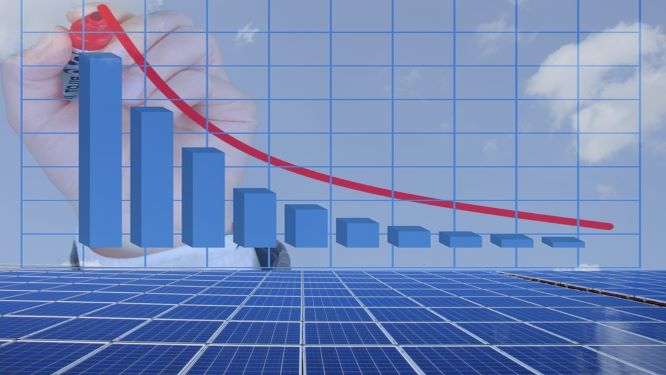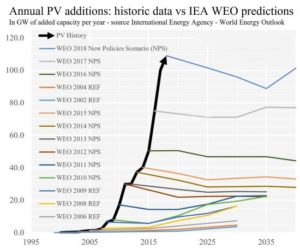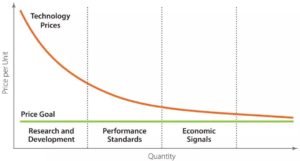

Understanding the dynamics of the silicon PV panels was always a difficult task. Fittingly, almost no expert predicted the movement in prices that we have seen over the past 5 years especially . Its phenomenal drop in prices has often baffled the market and its players as to why and what made these prices plummet to such levels, while other renewable sources still are struggling to get their moment of fame. If we look at the numbers, the good old photovoltaic panels prices have witnessed 99% of a price drop. If it were a sale, you would practically be buying groceries for free. This has single handedly given wings to the solar movement, with a ramp up of 5x to 10x in targets becoming the norm rather than rarity among countries and cities.
What happened that caused this solar technology git cheaper by 99%. Is it basic scientific research? Early-stage R&D? Learning by doing? Economies of scale?


So, the scientists at the MIT or Massachusetts Institute of technology researched on the dramatic drop in the cost of solar photovoltaic (PV) modules. The last 4 Decades which witnessed the 99% price drop is often touted as the major success story for the case of renewable power all over the world. It defied many projections from the likes of IEA over and over again.


MIT analysis through their complex research brought factors that have contributed to this success story. They found out that in early years, device-level R&D played a dominant role in driving costs down. The findings can show light to the policy level changes that needs to be implemented in other renewable sources of energy which are currently facing take-off difficulties. Like batteries, better electric cars, advanced nuclear reactors, hydrogen fuels, algae fuels, microgrids, carbon removal, and all the rest.
If we draw parallels with China, the country started off with mere village-level solar programs in 1990s. It was not until Germany and then Spain and Italy’s demand for Solar panels, which got the Chinese to take notice of growing solar panel demand. The Chinese then started investing heavily to produce solar panels. In fact, China in early 2000s was ready to invest as much as $47 billion dollars just to create a lucrative ecosystem to research and attract players from other countries working in the solar industry. Like Chinese company Hanergy which bought Solibro subsidiary of Q.Cells and MiaSolé in 2013 in US.
The MIT study goes on to say that in later years, R&D fell back a bit and economies of scale leaped forward. People started driving down costs by manufacturing massive amounts of PV panels. China started giving tax credits to the solar manufacturers and laborers working in the sector in the country. That means instead of paying taxes they got tax holidays and good PR, a win-win situation we must add. Contrary to market belief, Mass production scaled down the prices, not cheap skilled labor in China. Although flexible waste disposal norms were also probably a big help.
Chinese also provided loans and tax incentives to prop up its ‘strategic’ solar sector and copied Germany’s Feed-in-tariff model that paid handsome prices for electricity generated by rooftop solar. The result was a surge in domestic demand for solar.
The MIT paper also references two basic sorts of policies: first, publicly funded R&D, and second, “market-stimulating policies,” which create legal or economic incentives for private players into research, develop and invest in technologies.
Something, we in India need to learn from. The solar sector which was booming a year back has been stuttering so far in 2018. Deployments of newer technologies need public sector boost to make them relevant in the country’s energy mix. Especially when there are 34 stressed thermal power projects, with a capacity of 40 GW and a combined debt of Rs 1.7 lakh crore. Thermal power accounts for two-thirds of India’s electricity capacity. So If India wants to add more renewable power in its kitty, it better not repeat the blunders it did in the thermal sector and more recently in the Solar sector and ensure consistency in its economic policies.
It is worth repeating: policies that create incentives for private investors to develop and deploy solar panels are responsible for well over half of the decline in solar PV costs. Most of the rest is public R&D. And the real lesson remains: we know how to make renewable energy cheap (remember Rs 2.44 bid by ACME and Aditya Birla), now we must work to decarbonize and adopt cleaner as well as cheaper sources of energy and fast.
If we look at the major PV markets which have slowed all due to state intervention like in US, India, and China, if the state resumes its ‘enabler’ role and continue to facilitate the adoption of Newer Renewable energy sources, the success story of solar can be repeated. There are lessons here for other clean energy technologies we know we will need for decarbonization — like batteries, better electric cars, advanced nuclear reactors, hydrogen fuels, algae fuels, microgrids, carbon removal, and all the rest. It is possible to target public policy toward a technology based on its position on the learning curve and consciously accelerate its development. We can opt for 2025 as a year for our deadline so that cost-effectiveness can permeate into carbon-intensive sectors and then maybe by 2030, more and more people in the world can breathe in fresher air, drink cleaner water and live disease free.
1. The mandate for blending Compressed Biogas (CBG) with natural gas has come into effect…
Andhra Pradesh is striving towards greening its energy sector with quite some speed. In a…
With an objective to bolster India’s green energy goals, a Tripartite Agreement has been signed…
The Union MNRE Minister Pralhad Joshi launched the Green Hydrogen Certification Scheme of India (GHCI)…
India’s energy conglomerate Bharat Petroleum Corporation Limited (BPCL) has commissioned a 5MW green hydrogen plant…
In a historical development, the European Space Agency (ESA) has successfully launched its pioneering ‘Biomass’…